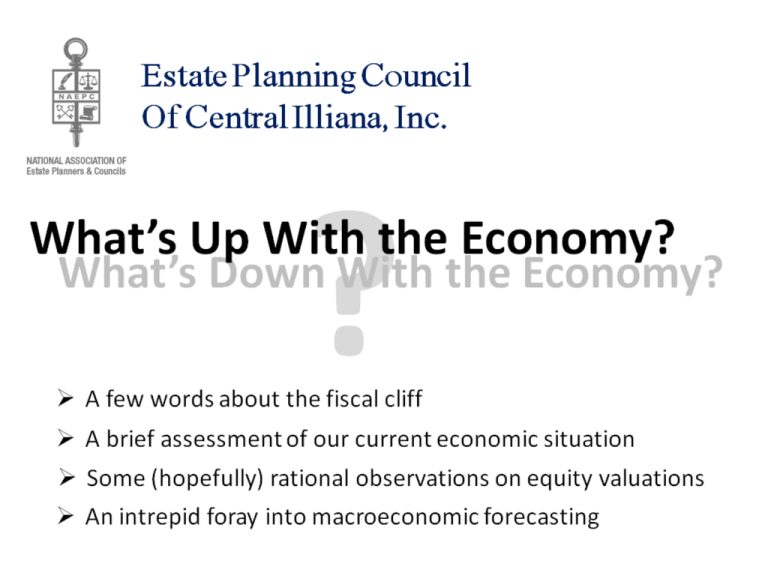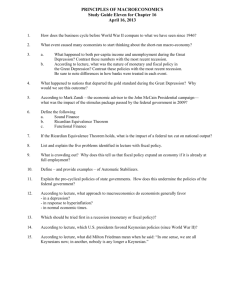Document 11670409
advertisement

What’s this I hear about a fiscal cliff? 600 330 400 Billions $ 200 0 420 108 -24 -51 -200 150 -40 -61 -400 ~3% of GDP -600 -800 Defense cuts Other cuts -503 -682 Expiration End of Net effect of Bush payroll tax on budget tax cuts holiday deficit Shorthand for a group of policy changes that will come together around Jan. 1 – expiration of Bush-era tax cuts, automatic spending cuts (“Sequestration”), alternative minimum tax starts kicking in … Conventional wisdom assumes that Congress will do something constructive in a lame-duck session. In September, a Goldman Sachs research note said there was a 1 in 3 chance that Congress would fail to pass even short-term measures to avoid a cliff. Or Is It More of a Slope? Key Elements of the “Fiscal Slope”: Expiration of the “Bush tax cuts” – reversion to marginal tax rates of 2000. Failure to enact a retroactive inflation adjustment for the Alternative Minimum Tax. Reversion to 2000 Estate Tax levels. Reinstitution of original payroll tax deductions (End of payroll tax “holiday”). New taxes associated with the Patient Protection and Affordable Care Act of (a.k.a., “Obamacare”) of 2010. “Sequestration” – automatic spending cuts. Not All Slopes Are the Same, … And Sometimes We Get to Choose Our Way Down And there is a way back up! The Long Road Back (From the 2008 – 2009 Recession) Jordà, Òscar, Moritz Schularick, and Alan M. Taylor. 2011. “When Credit Bites Back: Leverage, Business Cycles, and Crises.” NBER Working Papers 17621. The Long Road Back 16% Personal Saving Rate Smoothed Personal Saving Rate 14% 12% 10% 8% 6% 4% 2% 2012 2008 2004 2000 1996 1992 1988 1984 1980 1976 1972 1968 1964 1960 0% The Long Road Back We’re experiencing a very slow recovery from a “balance sheet recession” Richard Koo (2011), “The world in balance sheet recession: causes, cure, and politics.” RealWorld Economics Review 58, http://www.paecon.net/PAEReview/issue58/Koo58.pdf Martin Wolf (2012), “Getting out of debt by adding debt.” July 25, 2012, http://blogs.ft.com/martin-wolf-exchange/2012/07/25/getting-out-of-debt-by-addingdebt/#axzz27Ps9eoHx The “fiscal cliff” would amount to a shift to austerity by having the public sector deleverage while the private sector continue its own deleveraging. This could be detrimental to economic performance. Luckily, it’s more of a “slope” than a “cliff” Congressional Budget Office (2012), “Economic effects of reducing the fiscal restraint that is scheduled to occur in 2013.” http://www.cbo.gov/sites/default/files/cbofiles/attachments/FiscalRestraint_0.pdf “… in a depressed economy like the present, if a long deep recession casts even a small shadow on future potential output, with interest rates in the range at which the U.S. has been able to borrow, there is a substantial likelihood that expansionary fiscal policy right now would be self-financing, and an overwhelming likelihood that it would pass a benefit-cost test. Brad DeLong and Larry Summers, “Fiscal Policy in a Depressed Economy”, Brookings Papers, March 22, 2012. http://www.brookings.edu/~/media/Files/Programs/ES/BPEA/2012_spring_bpea_papers/2012 _spring_BPEA_delongsummers.pdf Evidence of a Balance Sheet Recession (and Recovery) New York Federal Reserve, 2012 Q3 Quarterly Report on Household Debt and Credit , November 27,2012. (This page added 1 week after the presentation.) A Very Brief Look at Equity Markets Corresponds to an ~ 8% annualized return. Historic range = 3.4% to 11.6% annualized returns. 1.3 } http://delong.typepad.com/sdj/2012/10/campbell-shiller-regressions-future-sp-price-changes-regressed-on-ratios-of-prices-to-long-runmoving-averages-of-past-earn.html “This is a major, major, empirical win for Campbell and Shiller. This is why only fools say today that movements in market-wide price-earnings ratios are best interpreted as shifts in rational expectations of future earnings and dividend growth. Instead, they are best interpreted as due to fads and fashions in how much people are willing to nerve themselves to pay for a dollar of earnings today …” A Very Brief Look at Equity Markets Shiller P/E10 http://www.multpl.com/shiller-pe/ Forecasting is not a strength of any economist, but that never stops us from trying … The Crystal Ball Business James Bullard, president of the St. Louis Federal Reserve Bank, told them he thinks the U.S. gross domestic product will grow 3.5 percent next year. While that’s above average, it might not sound exceptional to an uninformed listener. Bullard’s forecast puts him at odds with most private-sector economists. Three other forecasters who joined Bullard at Monday’s program said the economy remains stuck at a growth rate of just over 2 percent. Bullard was, he admitted, too optimistic heading into 2011 and 2012. “We expected a faster re-bound” from the recession, he said. “There have been drag factors, primarily housing and the situation in Europe.” Now, housing is showing signs of recovery, and the European Central Bank seems committed to keeping the continent’s banks afloat, no matter how many bail-outs the Spanish and Greek governments need. U.S. Economic Growth Over Time 20% Quarterly GDP Growth Rate HP-Smoothed GDP Growth Rate 15% 10% 5% ? 0% Various recent forecasts for 2013: FOMC September 13 2.5% to 3.0% NABE October 15 2.4% Phil. Fed November 9 2.0% -5% Source: Bureau of Economic Analysis data. Smoothed series generated using a Hodrick-Prescott filter. 2020 2015 2010 2005 2000 1995 1990 1985 1980 1975 1970 -10% Forecasting probabilities of recessions Historical U.S. Recession Probabilities June 1967 – August 2012 October 2011: ~ 19.6% Source: Jeremy Piger, University of Oregon, http://pages.uoregon.edu/jpiger/us_recession_probs.htm Forecasting probabilities of recessions Historical U.S. Recession Probabilities January 1960 – October 2012 100 90 Probability of Recession 80 70 60 50 40 30 November 2011: ~ 5.7% 20 10 Jan-12 Jan-08 Jan-04 Jan-00 Jan-96 Jan-92 Jan-88 Jan-84 Jan-80 Jan-76 Jan-72 Jan-68 Jan-64 Jan-60 0 Source: Kevin Christ, Rose-Hulman Institute of Technology, based on Estrella and Trubin, "The Yield Curve as a Leading Indicator: Some Practical Issues", NYFed Current Issues (2006), http://www.newyorkfed.org/research/current_issues/ci12-5.html Going out on a (fairly sturdy) limb… Various recent forecasts for 2013: FOMC September 13 2.5% to 3.0% NABE October 15 2.4% Phil. Fed November 9 2.0% 10% probability of recession. 0% 10% probability of “robust” growth. 1.2% 2.4% 3.6% GDP Growth Rate 4.8% Going out on a (fairly sturdy) limb… Downside risks are more pronounced than are upside opportunities Various recent forecasts for 2013: FOMC September 13 2.5% to 3.0% NABE October 15 2.4% Phil. Fed November 9 2.0% 0% 1.2% 2.4% GDP Growth Rate 3.6% Downside risks are more pronounced than are upside opportunities 1. Europe: There are some signs that the required political will is emerging and that some “structural adjustment” is underway. 2. China: The greatest threat to the U.S. economy of a slowdown in China is via rising geopolitical tension. 3. Failure to choose the right line down the fiscal slope: … especially when the housing and labor markets finally seem to be showing signs of recovery.




